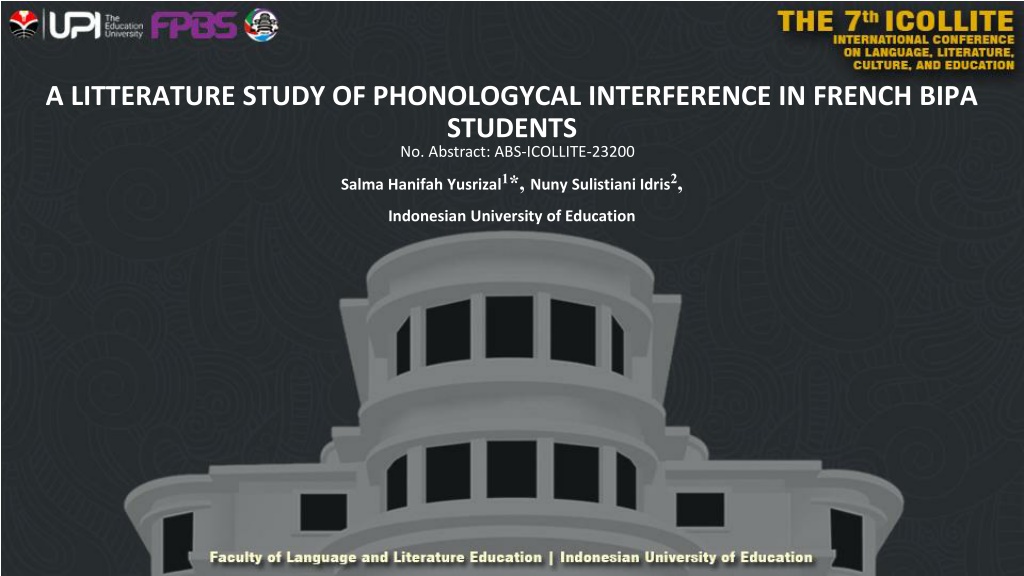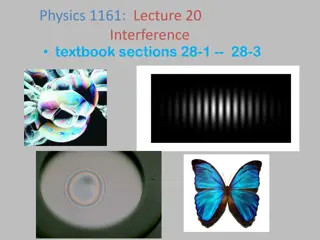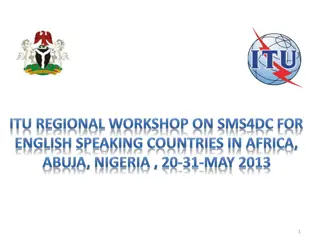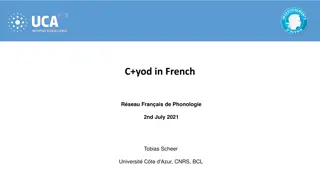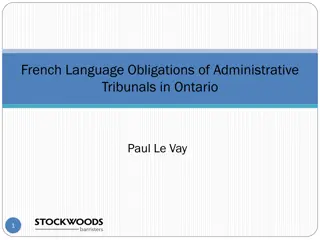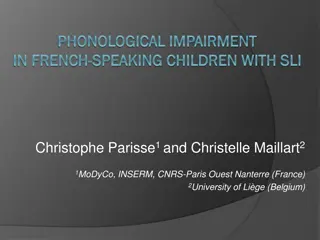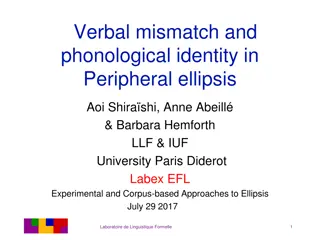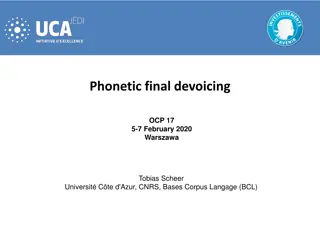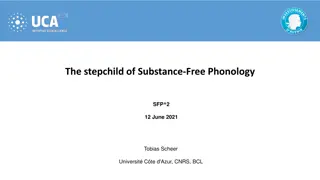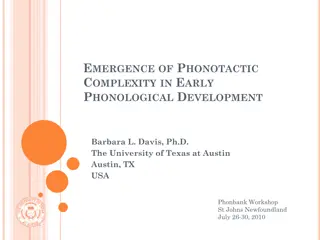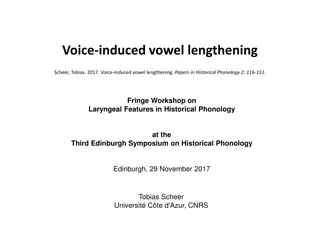Phonological Interference in French BIPA Students: A Literature Study
BIPA students face challenges in pronunciation due to phonological interference, especially in French-speaking students. This study explores the linguistic aspects contributing to pronunciation errors and proposes phonetic corrections. Literature review discusses language interference and factors influencing the process. Methods include data collection from relevant literature. Findings focus on Indonesian pronunciation errors in four phonemes compared to French vowel characteristics. The study aims to enhance understanding and address challenges faced by French BIPA students in phonology.
Download Presentation

Please find below an Image/Link to download the presentation.
The content on the website is provided AS IS for your information and personal use only. It may not be sold, licensed, or shared on other websites without obtaining consent from the author. Download presentation by click this link. If you encounter any issues during the download, it is possible that the publisher has removed the file from their server.
E N D
Presentation Transcript
A LITTERATURE STUDY OF PHONOLOGYCAL INTERFERENCE IN FRENCH BIPA STUDENTS No. Abstract: ABS-ICOLLITE-23200 Salma Hanifah Yusrizal1*, Nuny Sulistiani Idris2, Indonesian University of Education
INTRODUCTION One of the difficulties faced by BIPA students comes from linguistic aspects such as phonology. This is due to sound interference in the pronunciation of several phonemes in bahasa Indonesia. Including French BIPA students. This is proven in the research results of: 1. Adityarini et al (2020) which stated that sound interference was found in the pronunciation of the vowel e with the vowel sound [ ] in BIPA students from Europe in Bali, one of whom came from France. 2. As for Grang (2019) who stated that the letter "h" was not pronounced enough and the nasal sound of "ng" was too stressed, so it was pronounced like "ngg". 3. In addition, Lestari (2021) also found that there are three Indonesian consonant phonemes, namely / /r/ and /h/ which have the potential to cause pronunciation errors in bahasa Indonesia for French speakers.
LITERATURE REVIEW 1. Language Interference according to Weinrich (Ngalim, 2013) is the power of the inclusion of elements of another language into a particular language due to contact between them which refers to deviations in using a language by incorporating other language systems. Moeliono (2000 p.230) explains that if the elements of language that enter another language are disruptive, then such an event is called interference. 2. Suwito (1983, p.55) stated that interference can occur in all linguistic components and one of them is phonological interference. Uriel Weinreich (1968:2) argues, "Great or small, the differences and similarities between the other gauges in contact must be fully stated for each domain - phonic, grammatical, and lexical - as a prequisite for interference analysist". 3. Suwito (1983, pp. 54-55) categorizes three elements that play a role in the interference process, namely (1) the source language or donor language, (2) the absorbing or receiving language, and (3) the absorption or importation element.
METHOD Reseach Design Data Source Data collection Technique Data Analysist Technique Qualitative descriptive method Primary data : Literatures related with the phonological system in French and bahasa Indonesia or the research study such as journals, articles Documentation techniques Litterature Study (Sugiyono 2018)
FINDING AND DISCUSSION Based on the results of data analysis, the discussion regarding Indonesian pronunciation errors in French BIPA students and their phonetic corrections is focused on four phonemes, namely the phonemes e/, /, /h/, and /r/. Characteristics of French vowel phonemes Characteristics of bahasa Indonesia vowel phonemes The front is nout round / flat The front is not round / flat Tongue Posistion Middle not round/ flat Tongue Position High [i] High [i] [e] [e] [ ] In the Middle [ ] In the Middle [ ] [ ] [a] Low Low [a] (Yuliati, 2015) (Alwi et al, 2014)
FINDING AND DISCUSSION In the Indonesian phonological system, 'ng' or nasal sound / / is a group of velar nasal consonant sounds which means that air from the throat is inhibited and then air flows through the nose, and velar indicates the place of articulation where the tip of the tongue attaches to the soft palate just behind tooth. Meanwhile, in the French phonological system the nasal / / sound does not belong to the nasal consonant sound but is a vowel phoneme produced by pressing the tip of the tongue against the upper teeth and exhaling air through the nose. These vowel phonemes include: [ ] as in the word vin [v ] means wine or grapes [o ] as in the word parfum [parfo ] means perfume [ ] as in ton [t ] means yours [ ] as in the word un [ ] means one (Rakhmat et al, 2015) If seen from the explanation above, the uniqueness of nasal sounds in the French phonological system can trigger interference in the pronunciation of Indonesian words that have a velar nasal / / phoneme sound at the initial initial position of the syllable, such as ngaca [ aca] and 'ngopi' [ pi] is also in a position in the middle of syllables such as bunga [bu a], mengantri [m antri], cangkul [ca kul]. French speakers who become BIPA students tend to pronounce the phoneme / / at the beginning and in the middle of the syllable to / g/ because they think that 'ng' are two phonemes with different sounds
FINDING AND DISCUSSION the word chat for cat is pronounced [ a], the word hotel is pronounced [?otel], or the word hier meaning yesterday is pronounced [j :R]. Whereas in the Indonesian phonological system, the phoneme /h/ belongs to the category of fricative glottal consonants, which are produced by narrowing the vocal cords and forcing air out through the throat so that a whistling sound is heard. (Alwi et al, 2014) The phoneme /h/ in the French phonological system is often left unpronounced, such as vocabulary of French speakers. For example, in Indonesian, the word hari is often pronounce [?a i] by the French BIPA students, hadapi is pronounced [?adapi], or the word parah is pronounced [pa a]. This shows that this interference will cause changes in meaning which will make the speech partners of French BIPA students not understand the meaning of the vocabulary they want to convey. This causes an interference with the pronunciation of the phoneme /h/ in the Indonesian
FINDING AND DISCUSSION articulation occurs behind the upper teeth and air flows through the tip of the tongue which vibrates (rhotic). This rule applies to the phoneme 'r' which occurs at the beginning, in the middle or at the end of the syllable. Examples include rambut [rambut] , kerta [k rtas] and , ular [ular]. Whereas in the French phonological system 'r'[ ] is a uvular consonant phoneme produced by the constriction between the uvula and the back of the tongue being vibrated. For example, the word gar on means boy is pronounced [ga s ],, the word r ve means dream is pronounced [ v] and the word bonjour means hello is pronounced [b u ]. In bahasa Indonesia phonological system 'r' is a vibrating alveolar consonant, where the different places of articulation in the phonological systems of Indonesian and French, so what French BIPA students often pronounce is [ ]. For example, the word rambut in Indonesian is often pronounced [ ambut], kerta is pronounced [k tas], and snake is pronounced [ula ] Therefore, the interference that occurs in the consonant phoneme 'r' occurs because of
CONCLUSION sounds properly and correctly. This is caused by various factors, one of which is the influence of the learner's mother tongue when someone learns a second language or a foreign language, in linguistics known as interference. As found in the field, BIPA students are faced with difficulties in pronouncing phoneme interference, is French BIPA students. Indonesian phonemes that are often interfered with by French BIPA students are the phonemes /e/, / /, /h/, and /r/. This is because the way of pronunciation or place of articulation of these phonemes in Indonesian and in the learner's mother tongue, namely French, is different. One of the BIPA students who often experiences interference, especially phonological
REFERENCES Alwi, H., Dardjowidjojo, S., Lapoliwa, H., & Moeliono, A.N. (2003). Tata Bahasa Baku Bahasa Indonesia (Edisi III). Jakarta: Balai Pustaka. Adityarini, I.A.P, Pastika, I.W dan Sedeng, I.N. (2020). Interferensi Fonologi Pada Pemelajar BIPA Asal Eropa di Bali. Aksara, 32 (1), 167-180. DOI: 10.29255/aksara.v32i1.409.167-186 Grang , P. (2019). Tantangan Pengajaran Bahasa Indonesia di Prancis. Seminar Internasional Riksa Bahasa. http://proceedings.upi.edu/index.php/riksabahasa/article/view/847 Lestari, D. (2021). Penerapan Fonetik Artikulatoris Dalam Pembelajaran BIPA Di Prancis. In Prosiding Seminar Nasional Linguistik dan Sastra (SEMNALISA) (Vol. 1, No. 1, pp. 30-36). Moeliono, A.(2000). Kajian Serba Linguistik. Jakarta: PT BPK Gunung Mulia. Ngalim, A. (2013). Sosiolinguistik: Suatu kajian fungsional dan analisis [Sociolinguistics: A functional study and analysis]. Solo: PBSID FKIP UMS Rakhmat, S., Mutiarsih, Y., Darmawangsa, D. (2015). Pembelajaran Pelafalan Bahasa Prancis Melalui Model Artikulatoris Pengembangan (MAP) Berbasis Multimedia Interaktif. Jurnal Pendidikan Bahasa dan Sastra, 15 (1). https://doi.org/10.17509/bs_jpbsp.v15i1.802 Suwito.(1983). Pengantar Awal Sosiolinguistik: Teori dan Problema. Surakarta: Fakultas Sastra, Universitas Sebelas Maret. Weinreich, U. (1953). Languages in Contact: Findings and Problems. New York: Linguistic Circle of New York. Yuliati, R. (2015). Fonologi Bahasa Prancis. Jurnal Puitika, 11 (1), 26-35. http://jurnalpuitika.fib.unand.ac.id/index.php/jurnalpuitika/article/view/10/7
THANK YOU! Follow us @...
